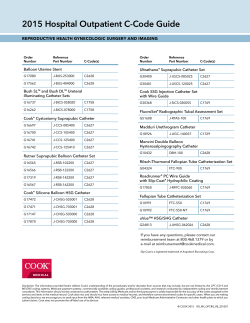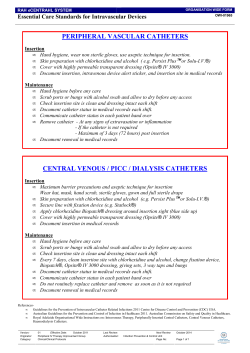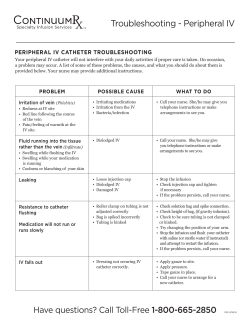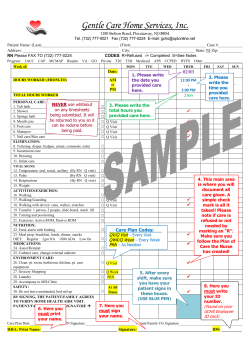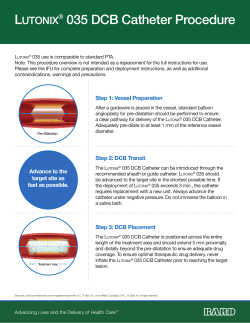
Instructions for Use - Clinical Innovations
Latex Free PVC Free Clinical Innovations, Inc. 747 West 4170 South Murray, Utah 84123 Phone 801- 268-8200 Fax 801- 266-7373 Toll Free 888- 268-6222 Sterile - Unless package has been opened or damaged. Single Use Only - DO NOT REUSE OR RESTERILIZE. Caution - Federal law restricts device for sale to or on order of a physician. Attention - Read instructions before using this product. Contents 1. One sterile disposable Koala® catheter with introducer. 2. Adhesive pad to secure the Koala to patient. Description The Clinical Innovations' Koala is a disposable Intrauterine Pressure Monitoring System. This is a sterile, single patient use device designed for measurement of intrauterine contraction pressures. Indications For use on patients requiring intrapartum intrauterine pressure monitoring. Contraindications Do not use if there is bleeding of undetermined origin, diagnosed or suspected placenta previa, or nonruptured amniotic membranes. Warnings Insertion should be performed carefully and gently, using aseptic technique. If resistance is encountered, determine alternate area for insertion. Forced insertion may result in malfunction, patient discomfort, or patient/fetal trauma. Adverse Reactions Perforation of placenta, umbilical cord, or uterus and infection. Instructions for Use Catheter Preparation 1. Gather necessary supplies: Koala catheter, appropriate cable/connector which links Koala to fetal monitor, and infusion fluid with IV tubing if performing amnio communication (see Figure A). Figure A Amnio Communication Port Removable Protective Cap Reusable Cable/Connector 2. 3. 4. 5. Soft Tip Introducer Insertion Depth Indicators (1) Disposable Catheter Turn fetal monitor ON. Plug cable/connector into fetal monitor outlet designated UA or UC. Open pre-sterilized Koala catheter package. Inner pouch may be used for sterile transfer. Per standard protocol, using aseptic technique, remove catheter from package and prepare for insertion. Figure B Introducer Catheter Insertion, Zeroing, and Removal 23. Remove cap from amnio port. 24. Fill IV tubing intended for amnio communication procedure with solution designated by physician or hospital. 25. Attach IV tubing to amnio communication port of the Koala. 26. Infuse IV fluid or withdraw sample at rate established by physician or by hospital protocol. IF EXCESSIVE FLUID LEAKAGE FROM THE PATIENT OCCURS, CHECK CATHETER PLACEMENT. Catheter Placement Amnion Chorion et ria lL ini ng Amniotic Fluid Space do En m Amniotic Space Placement Amnion Chorion ini ng Amniotic Fluid Space lL Amnio Communication Procedure Figure C et ria Ensure amniotic membranes are ruptured and cervix is adequately dilated. Perform vaginal exam, and with index finger, palpate fetal presenting part to determine optimal position for placement. Ensure amnioport is vented by confirming filtered vented cap is in place on amnioport. Insert introducer and catheter through vagina up to cervical os. Secure introducer between examining fingers adjacent to fetal presenting part. DO NOT EXTEND INTRODUCER BEYOND FINGERTIPS. 10. Advance Koala 10-14 cm into uterus by inserting catheter until bottom of introducer is at text “Pause for Flashback”. (See Figure B). 11. Ensure that catheter has been placed in amniotic space (see Figure C), by watching for amniotic fluid flowing through catheter length. EVIDENCE OF BLOOD INDICATES EXTRAOVULAR PLACEMENT. 12. If catheter placement does not proceed easily or fluid is not visualized in catheter: a. Pull back catheter tip to introducer and alter catheter direction by changing angle of introducer or, b. Determine alternate position for placement and proceed with insertion. Repeat steps 10, 11 and 12 until you are comfortable the IPC is properly placed. DO NOT USE EXCESSIVE FORCE OR CAUSE PATIENT TRAUMA 13. Advance Koala into proper position until double mark (45 cm) is at introitus. This indicates tip of catheter has progressed 30-45 cm into uterus and should be positioned at fundus of uterus (see Figure A, #1) 'STOP' MARKING SHOULD STILL BE VISIBLE OUTSIDE VAGINA. 14. Following insertion and placement confirmation, carefully slide introducer back along catheter. Push introducer along ramp or pull catheter through introducer slot for removal. (see Figure D). 15. Hydrophobic filtered vented cap may be removed and replaced by tethered cap, or it may be left in place. 16. To secure Koala, remove paper from center portion of adhesive pad and secure catheter or cable/connector to center of pad (pinch adhesive pad around it). Remove remaining paper from adhesive pad and secure to patient's thigh as close to introitus as possible to prevent a bend from working catheter out of uterus. (see Figure E, #1). 17. Zero monitor according to individual manufacturer's instructions. For true zero, ensure catheter is disconnected from cable/connector and zero monitor. Do not zero monitor while holding cable button (if present). 18. Remove yellow protective cap from catheter. Connect cable/connector to catheter (see Figure E, #2). Connection to catheter must be performed after placement into uterus. 19. Verify proper placement by encouraging patient to cough and confirming a sharp spike on uterine activity tracing. 20. Document insertion in medical record. Record time of insertion on uterine activity tracing (if not done automatically by monitor). 21. If Koala does not respond: a. Confirm cable/catheter is correct for monitor. b. Disconnect catheter from cable/connector, flush 10cc - 20cc through amnio port, then reconnect. c. Disconnect catheter from cable/connector, rotate, retract, or advance catheter, wait 15 seconds, then reconnect. 22. To remove Koala, grasp catheter and pull gently until fully withdrawn. Disconnect catheter from cable/connector. Discard catheter and store reusable cable/connector for future use. FOR FLASHBACK 6. 7. 8. 9. do En m Extraovular Placement filtered, vented cap Figure D nonvented cap Figure E 1 2 P/N 054-0044 Rev A
© Copyright 2025
